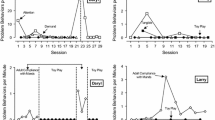Abstract
One component of a well-researched, standardized parent training program is to spank children for escape from time-out. The contribution of the spanking component to compliance acquisition in a clinic analog setting was evaluated. Time-out duration and child disruption at time-out release were balanced across spank and no-spank (“barrier”) conditions. Sixteen noncompliant, clinic-referred preschool children participated. The data indicated that both spank and barrier procedures were equally effective at increasing compliance ratios. Physical punishment did not appear to be a critical component. Given prior research, it was concluded that the enforcement of a minimum time-out duration is critical for compliance acquisition within the analog setting.
Similar content being viewed by others
Reference note
Hanf, C.A two-stage program for modifying maternal controlling during mother-child (M-C) interaction. Paper presented at the Western Psychological Association Meeting, Vancouver, B.C., 1969.
References
Baum, C. G., & Forehand, R. Long term follow-up assessment of parent training by use of multiple outcome measures.Behavior Therapy, 1981,12, 643–652.
Bean, A. W., & Roberts, M. W. The effect of timeout release contingencies on changes in child noncompliance.Journal of Abnormal Child Psychology, 1981,9, 95–105.
Bernai, M. E., Duryee, J. S., Pruett, H. L., & Burns, B. J. Behavior modification and the brat syndrome.Journal of Consulting and Clinical Psychology, 1968,32, 447–455.
Drabman, R. S., & Creedon, D. L. “Marking timeout” A procedure for away from home disruptive behavior.Child Behavior Therapy, 1979,1, 99–101.
Eyberg, S. M., & Ross, A. W. Assessment of child behavior problems: The validation of a new inventory.Journal of Clinical Child Psychology, 1978,7, 113–116.
Forehand, R. Child noncompliance to parent commands: Behavioral analysis and treatment. In M. Hersen, R. M. Eisler, and P. M. Miller (Eds.),Progress in behavior modification. Vol. 5. New York: Academic Press, 1977.
Forehand, R., & King, H. E. Noncompliant children: Effects of parent training on behavior and attitude change.Behavior Modification, 1977,1, 93–108.
Forehand, R. L., & McMahon, R. J.Helping the noncompliant child: A clinician's guide to parent training. New York: Guilford Press, 1981.
Forehand, R., Wells, K. C, & Griest, D. L. An examination of the social validity of a parent training program.Behavior Therapy, 1980,11, 488–502.
Hays, W. L., & Winkler, R. L.Statistics: Probability, inference, and decision. (Vol. II). New York: Holt, Rinehart, & Winston, 1970.
Hobbs, S. A., & Forehand, R. Effects of differential release from time-out on children's deviant behavior.Journal of Behavior Therapy and Experimental Psychiatry, 1975,6, 256–257.
Hobbs, S. A., Forehand, R., & Murray, R. G. Effects of various durations of timeout on the noncompliant behavior of children.Behavior Therapy, 1978,9, 652–656.
Lavigueur, H., Peterson, R. F., Sheese, J. G., & Peterson, L. W. Behavioral treatment in the home: Effects on an untreated sibling and long-term follow-up.Behavior Therapy, 1973,4, 431–441.
Roberts, M. W. Resistance to timeout: Some normative data.Behavioral Assessment, 1982,4, 237–246.
Roberts, M. W. The effects of warned versus unwarned time-out procedures on child noncompliance.Child and Family Behavior Therapy, 1982,4, 37–53.
Roberts, M. W., Hatzenbuehler, L. C, & Bean, A. W. The effects of differential attention and time out on child noncompliance.Behavior Therapy, 1981,12, 93–99.
Wells, K. C., Griest, D. L., & Forehand, R. The use of a self-control package to enhance temporal generality of a parent training program.Behaviour Research and Therapy, 1980,18, 347–358.
Author information
Authors and Affiliations
Additional information
The authors wish to express their appreciation to Bryan Hutchinson, Lynn McIssac, Larry Murillo, and Mary Parpal for their assistance in conducting this study.
Rights and permissions
About this article
Cite this article
Day, D.E., Roberts, M.W. An analysis of the physical punishment component of a parent training program. J Abnorm Child Psychol 11, 141–152 (1983). https://doi.org/10.1007/BF00912184
Received:
Issue Date:
DOI: https://doi.org/10.1007/BF00912184




